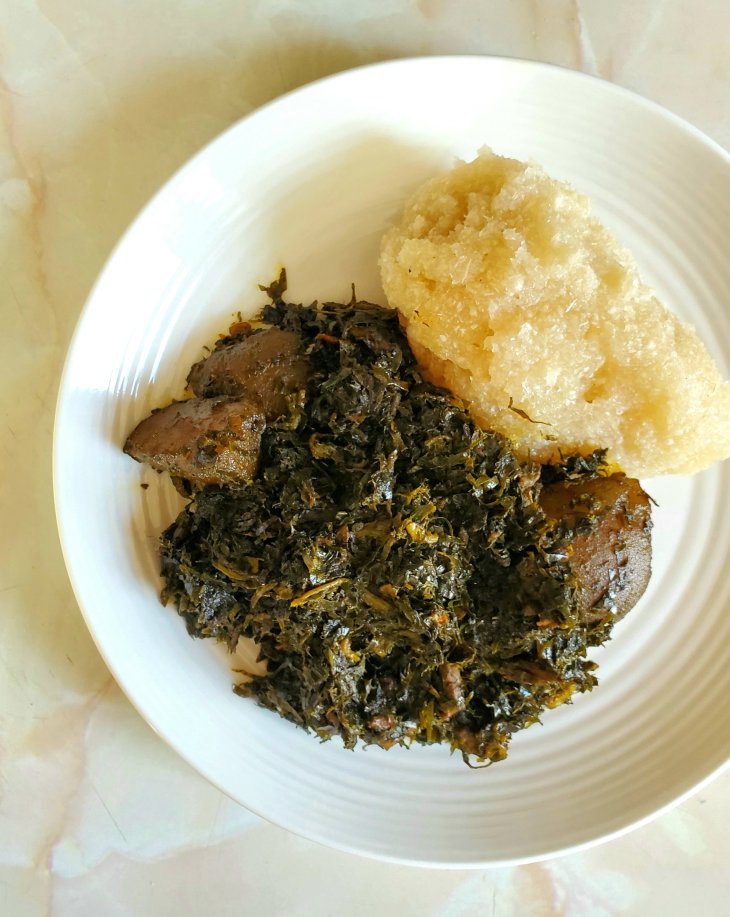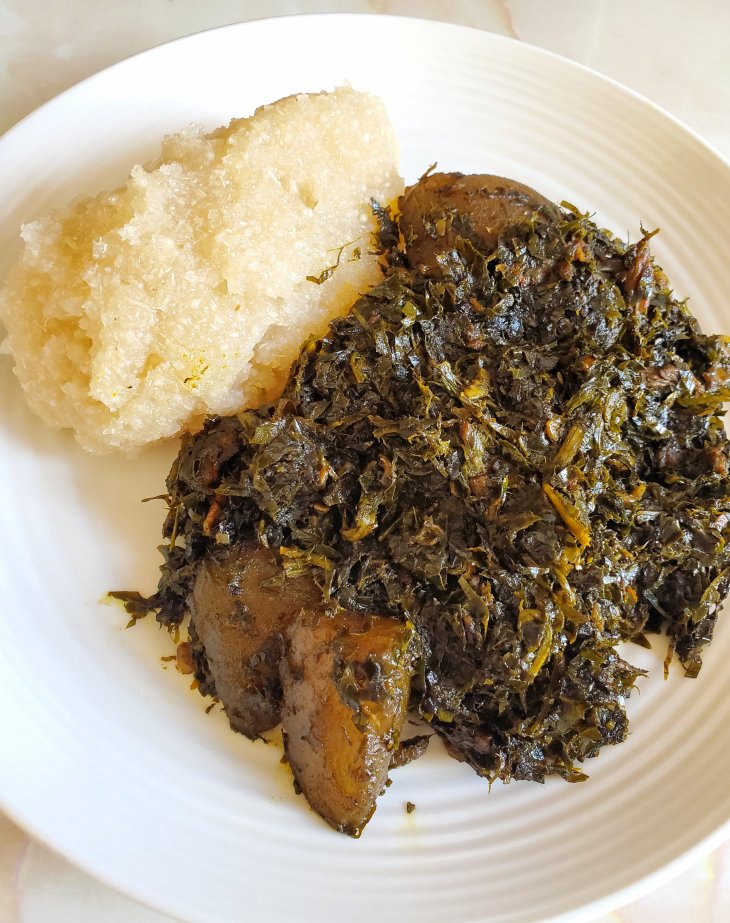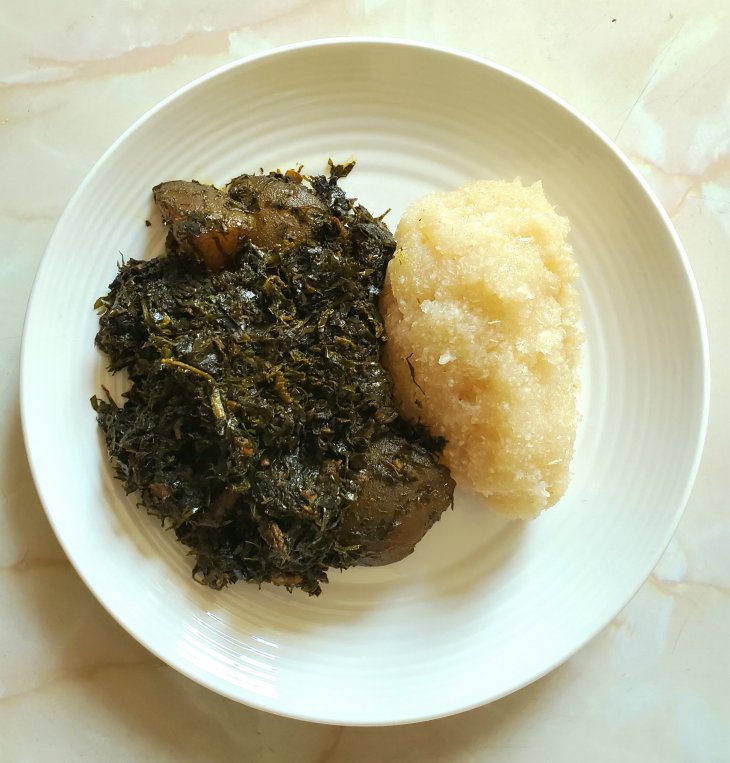Eru
Eru is a classic Cameroonian dish. This is a meal that is great on any regular day of the week and for special occasions alike. It is nutritious, delicious and its flavor is one of a kind. It is very simple yet uses ingredients that are often tricky to find outside of West Africa. But not impossible to find. I found all of them at an African store not far from me and you can too.

Some things you should know about Eru:
- First of all to pronounce Eru; the E should sound like the A in apron and the U should sound like the U in studio. That’s the best explanation I can come up with lol.
- Eru is also known as Okazi, especially to Nigerians. Its scientific name is Gnetum africanum (I had to google this). It is a leaf that is native to tropical Africa.
- It is a pretty coarse vegetable which is why Eru is always made with Waterleaf. Waterleaf is also native to West Africa and some other tropical areas in the world and is similar to spinach.
- Eru is best with Waterfufu, Koum Koum (another type of fufu) or garri which are all made of cassava. Here I am using garri which you can also find at any African store and even some big grocery stores.
For the longest time I thought most African stores didn’t have Eru because I didn’t know it is also called Okazi 🤦🏾♀️. But when I found out that it was the same thing I finally began to use up the Eru my mom gave me ages ago. I happened to have Waterleaf that my aunt had given me a while back too but you can easily sub it with spinach.

As some of you may know by now, growing up I was not interested in cooking; I learned/I am learning most Cameroonian recipes as an adult. This was one of those recipes I had to call my mom for. From talking to her and with help from my sister I realized how easy it is to make but the tricky part was putting this into a recipe.
You know how it is with recipes that you learn from a parent. They are more like “you want a good amount of crayfish,” or “you just want enough oil for it to shine”. The shine part are actual directions from my mother on more than one recipe lol. Well after some effort I have succeeded in putting this in a recipe for you. Still when making this along with my other recipes, I hope you get used to testing, tasting and using my notes and directions to figure out what works best for you.

Things to keep in mind when making Eru:
- The meats: We normally use beef, dried fish and canda for this. But you can use smoked turkey, or some other type of meat instead. I didn’t even include dry fish in the recipe below.
- Canda: Canda is pretty much beef skin. It goes by different names in different countries but if you ask for beef skin at an African store they will most likely know what you are talking about. I made it optional though because not everyone cares for its texture. Also depending on how well it was cleaned, you might still need to burn some hairs off. So if this sounds like too much for you, just omit the canda and double the other meat.
- Eru: Once again, Eru also goes by Okazi. When you go looking for it at an African store, check for both names. You will usually find it dried so you will have to soak it for a little bit before rinsing and cooking. If it isn’t dried, you don’t have to soak it.
- Spinach: Overall, you want the vegetables to be tender so you want a good spinach to Eru ratio. Start with less Eru then add until it is a pretty even ratio and not mostly one or the other. You’ll know.
- Scotch Bonnet Pepper: I almost made the scotch bonnet pepper optional but I don’t think Eru is the same without it. I think Eru is best spicy but should at least have that scotch bonnet pepper flavor. To impart the flavor, you can just drop these whole in the pot and squish it with your spoon a bit. The more you squish and the longer you cook the pepper, the spicier it will get. But you will need to really crush these for the Eru to be spicy. So just keep that in mind when squishing the peppers and remember to taste and adjust.
- Palm oil: I say 1 to 2 cups of palm oil so it is really up to you but you don’t want too little. Start with one cup and you can add a little more if the palm oil flavor is not much or if it is looking dull. I will tell you the same thing my mother says, you want it to shine.
- Eating: Finally, please don’t be boujie and use a fork. Eat these with your hands 🙂 It is not by force but just do it ok? Ok now unto the recipe!








Eru
- 1 pound beef, cut into pieces (2 pounds if not using beef skin)
- 1 pound boiled beef skin (canda), optional
- 2 pounds spinach or waterleaf
- 5 to 6 cups Eru (Okazi)
- 1 cup crayfish, crushed
- 2 maggi or bouillon cubes
- Salt to taste
- 1 to 2 scotch bonnet/habanero peppers
- 1 to 2 cups palm oil
- Water
Method
Add meat to a pot over medium high heat. Season with salt and pour in about two to three cups of water. If using canda, boil longer before adding beef. Cover and let the meat cook until tender.
In the meantime, soak Eru leaves in warm water for about 10 minutes then rinse and drain out the water. Add spinach or Waterleaf to the pot and stir then stir in Eru and crayfish. Add maggi cubes and scotch bonnet pepper. Using the back of a spoon, crush the maggi fully and crush the pepper enough to release its flavors.
Next, pour in palm oil and cook for another 10 to 15 minutes or until the Eru is tender and most of the water has evaporated from the dish. Taste for salt and adjust as needed before turning off the fire. Serve hot with garri or fufu of your choice and enjoy.



